-
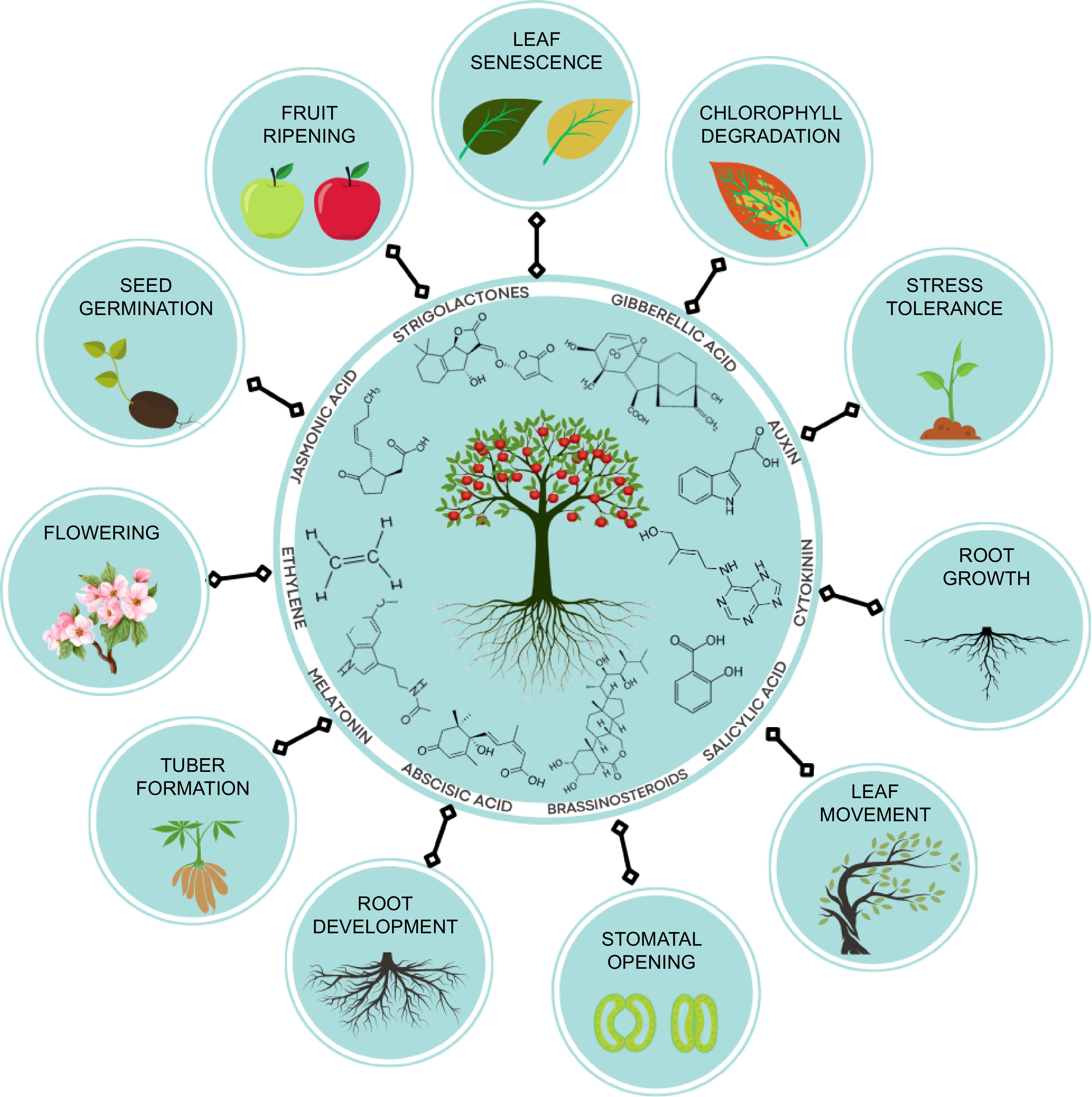
Figure 1.
Diagram illustrating the chemical structures and functions of hormones utilized to promote the growth/development and productivity of fruit crops.
-
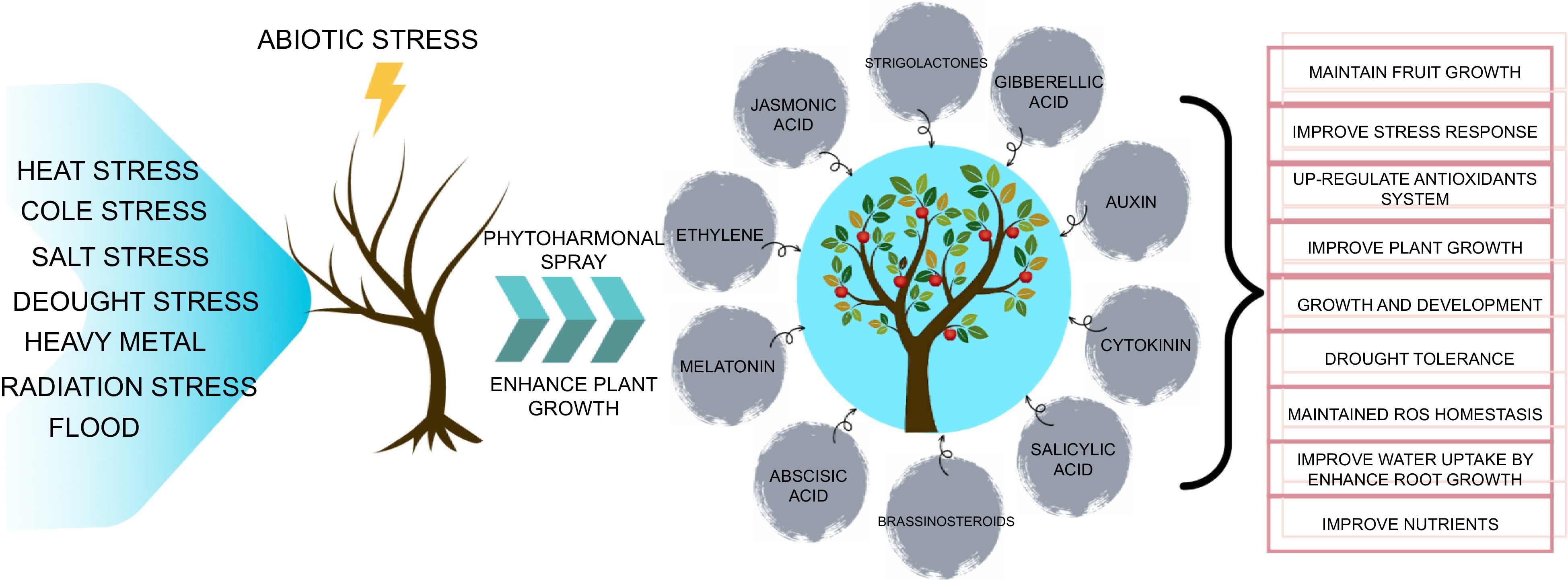
Figure 2.
Phytohormones have been recognized as major regulators in facilitating the adaptive responses of plants to diverse abiotic stress conditions, thereby playing a crucial role not only in stress tolerance but also in promoting growth, development, and ultimately enhancing the overall productivity of horticultural crops. Through intricate signaling pathways and molecular mechanisms, these phytohormones such as brassinosteroids (BRs), gibberellin (GA), jasmonates (JAs), salicylic acid (SA), strigolactones (SLs), abscisic acid (ABA), and melatonin (MEL) orchestrate a complex network that modulates physiological, biochemical, and morphological changes, enabling plants to overcome the detrimental effects of abiotic stressors. Therefore, understanding the multifaceted roles and interactions of phytohormones in horticultural crop systems represents a vital avenue for devising innovative strategies to enhance adaptability, optimize growth, and maximize yield under challenging environmental conditions.
-
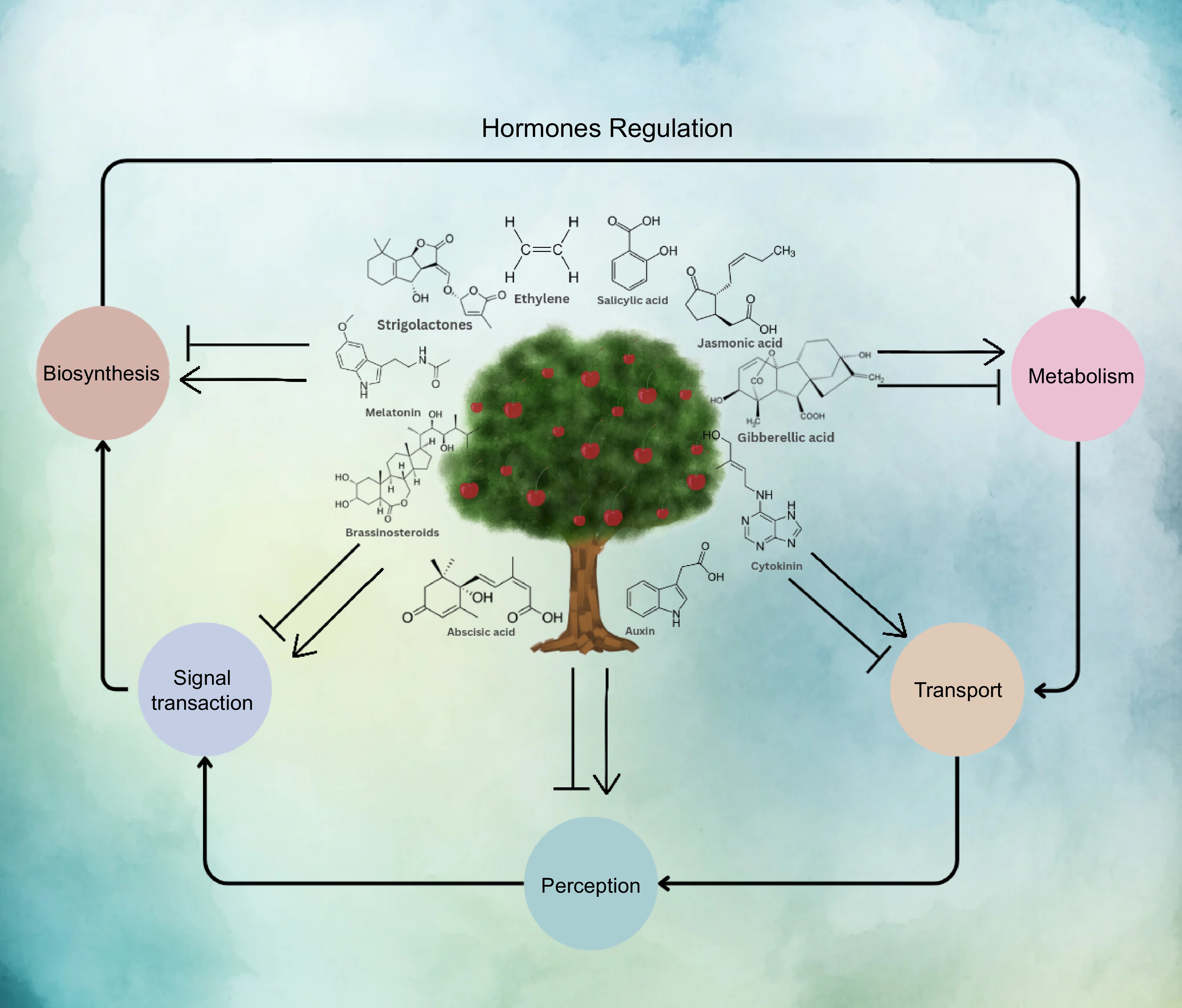
Figure 3.
The role of plant hormones in regulating plant growth and development by manipulating biosynthesis, metabolism, transport, and signal transduction of plant phytohormones.
-
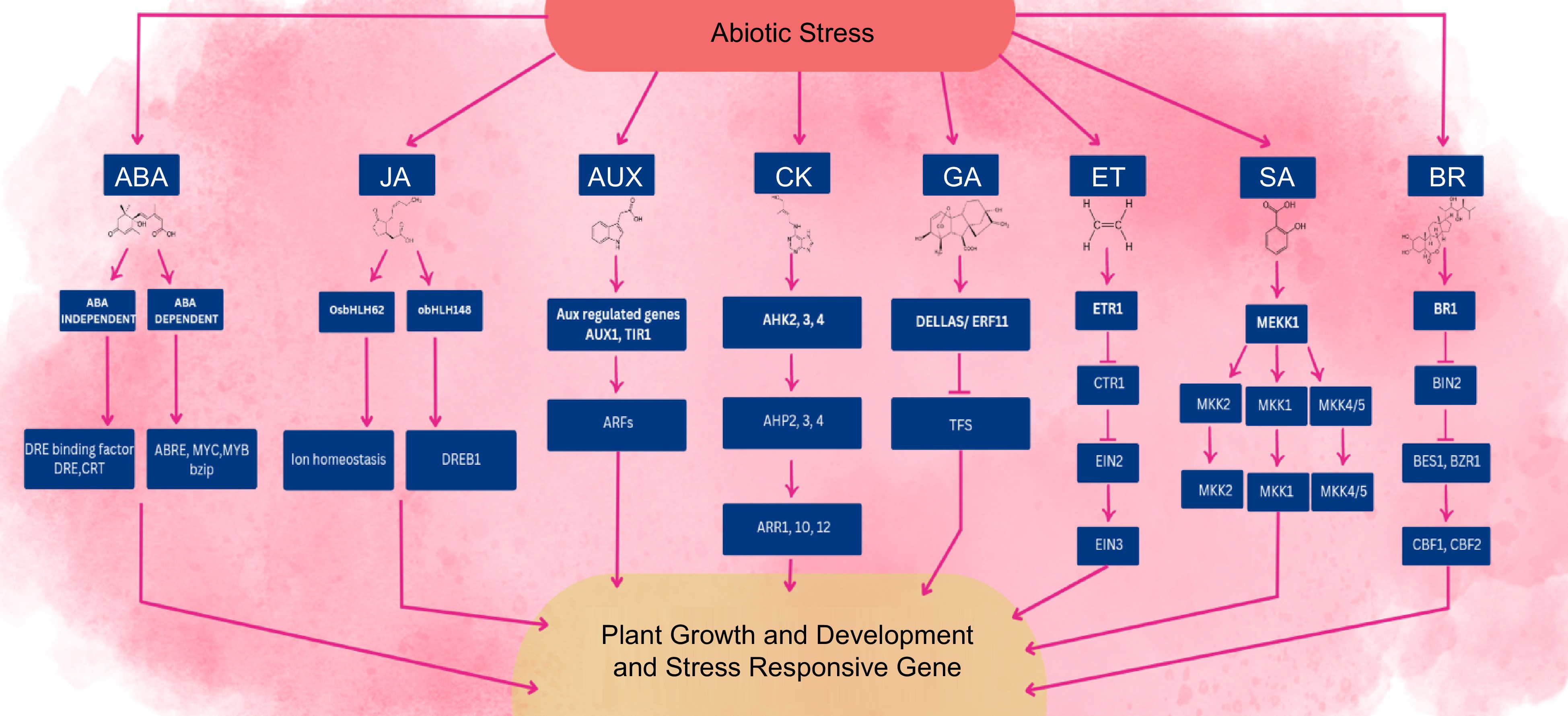
Figure 4.
An overview of phytohormone crosstalk and their signaling networks in abiotic stress responses. Under various conditions of abiotic stress, plant growth, and development are impacted by changes in phytohormonal signaling. Biosynthesis and signaling pathways of hormones are altered, which can affect specific genes within this network that are responsible for improving plant growth and defensive mechanisms to confer abiotic stress tolerance. The arrows bar end and simple arrow suggest repression effect and activation, respectively.
-
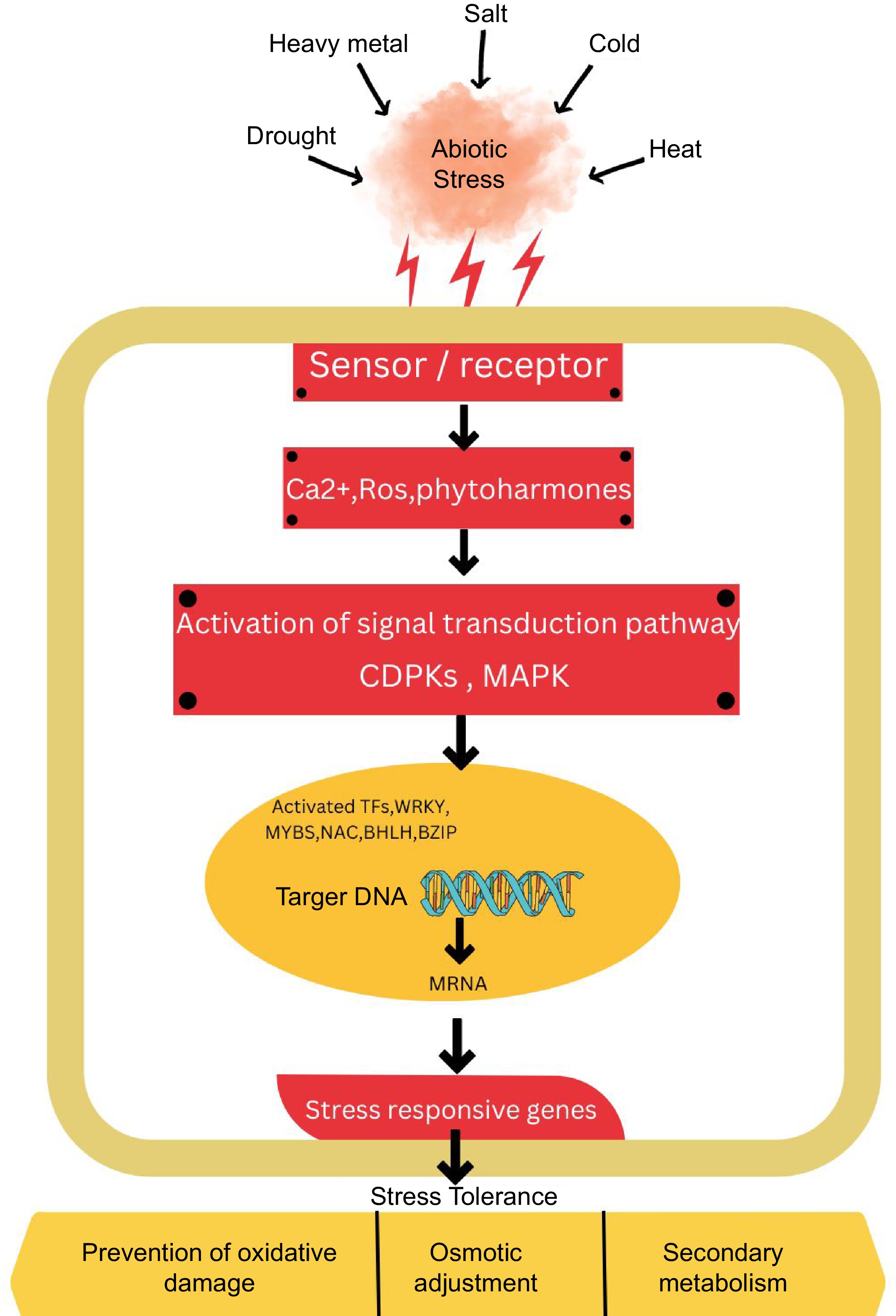
Figure 5.
The diagram illustrates the generic signaling pathway that plants use to respond to abiotic stress. The pathway begins with the perception of signal and extends towards stress responses. Initially, receptors and sensors perceive stress and cascading downstream stress responses via reactive oxygen (ROS), Ca2+, and phytohormones. Secondary messengers facilitate the transmission and amplification of signals in plants. This process involves the modulation of transcription factors and stress-responsive genes, which in turn triggers various molecular, biochemical, and physiological responses that contribute to enhancing stress tolerance in plants. The extension and transduction of signals are facilitated by secondary messengers. These secondary messengers result in the different regulation of stress-responsive genes and transcription factors. The regulation of TFs and genes leads to the adjustment of biochemical, physiological, and molecular responses that ultimately enhance stress tolerance in plants.
-
Plant Phytohormone Effect Reference Melon SA The upregulation of the antioxidant defense system by salicylic acid helps to alleviate the inhibitory effects of cadmium on photosynthesis and plant growth [146] Pepper SA Exogenous salicylic acid plays a function in decreasing the impact of extreme temperature [71] Orange BRs Increased accumulation of secondary metabolites plays a significant response to low temperature stress [147] Orange SA To reduce heat stress conditions under SA [148] Banana AUX AUX regulate to salt stress [149] Grape SA Enhance cold stress tolerance under SA [150] Citrus ABA To negatively regulate water-stress under ABA treatment [151] Banana AUX Regulation of heat stress [149] Orange BRs Regulating antioxidant enzymes enhances cold stress tolerance [152] Apple ABA Upregulating expression of the mdsat1 gene enhance resistance to drought and salt stress [153] Grape BRs Elicitation of antioxidant enzymes, including peroxidase, superoxide dismutase, ascorbate peroxidase, catalase, and improves the self-life of fruit under cold storage
[154]Banana SA Decrease the photooxidative and heat stress [155] Grape wine ABA Upregulating of genes involved in chlorophyll synthesis, heat shock proteins, and defense-related genes improves drought tolerance [156] Mango ABA Water stress tolerance increase under ABA [157] Tomato Melatonin The mitigation of nickel toxicity in tomato seedlings is achieved by improving root architecture system, nutrient uptake fluxes, antioxidant potential and photosynthesis
[5]Tomato Ethylene The in vitro improvement of salinity-tolerant tomato is mediated by ethylene-induced physiological responses [16] Fragaria vesca ABA FveHDZs play a role in ABA-mediated processes. [153] Citrus ABA anoxia tolerance increased by ABA [158] Tomato Melatonin Melatonin can alleviate nickel phytotoxicity in tomato seedlings by improving secondary metabolism, oxidative stress tolerance and photosynthesis [67] Banana SA The activities of H2O2-metabolizing enzymes can be changed by salicylic acid, which can increase the chilling tolerance of banana seedlings [74] Grape wine BRs Regulating protein, sugar, and proline accumulation can enhance chilling stress tolerance [159] Citrus ABA Increasing ABA concentration in young leaves and Arbona can improve water stress tolerance. [160] Banana BRs Enhances the ability to tolerate high temperature at a concentration of 0.2 µm [161] Sweet orange ABA Under salt and water stress, an increase in the expression of Late Embryogenesis Abundant (LEA) proteins [162] Apple Ethylene The upregulation of the mdmyc2 gene enhances aluminum stress tolerance [163] Pepper SA Effect of ultraviolet radiation on inducing oxidative stress in leaves of pepper [76,164] Apple GA Enhance germination of seed under cold stress conditions [165] Grape ABA Exogenous application of ABA enhances resistance to different abiotic stresses [166] Apple Ethylene The upregulation of the mdnac047 gene enhances salt stress tolerance [163] Banana JA Polyethylene glycol (PEG) mediated water stress can be alleviated and oxidative stress can be reduced [167] Peach JA Hot air combined with MeJA vapor treatment can alleviate chilling injury in peach fruit [103] Almond ABA Regulate the movement of xylem sap under stress conditions of water [168] Apple JA ABA biosynthesis by the regulation of sunburn [169] Strawberry SA Mitigate salt stress by enhancing the leaf water holding capacity of plants, as reflected by the increase of water relative content in leaves [170] Strawberry ABA Maintaining fruit quality even under drought and salt stress conditions. [171] Apple AUX Plants can regulate photooxidative and heat stress by cross-talking with ethylene [169] Pear JA Phospholipid remodeling promotes alleviation of chilling injury [172] Apple GA Improved salt tolerance has been observed through the upregulation of the transcription factors mdbzr1 and mdbzr1-2like [173] Apple Ethylene The upregulation of mderf1b–mdcibhlh1 genes improves cold tolerance [173,174] Pea ABA Enhanced accumulation of abscisic acid in young leaves enhances water stress tolerance [175] Apple AUX Root development rate and architecture are maintained to minimize drought stress [176] Apple JA Regulating xylem sap movement improves water stress tolerance [177] Strawberry SA Combination with iron nanoparticles reduces the impact of drought stress under in vitro conditions [178] Apple BRs Regulating the photosynthesis mechanism can help minimize effects under water stress [179] Table 1.
Phytohormones and other associated compounds in the regulation of abiotic stress-impacts in horticultural crops.
Figures
(5)
Tables
(1)